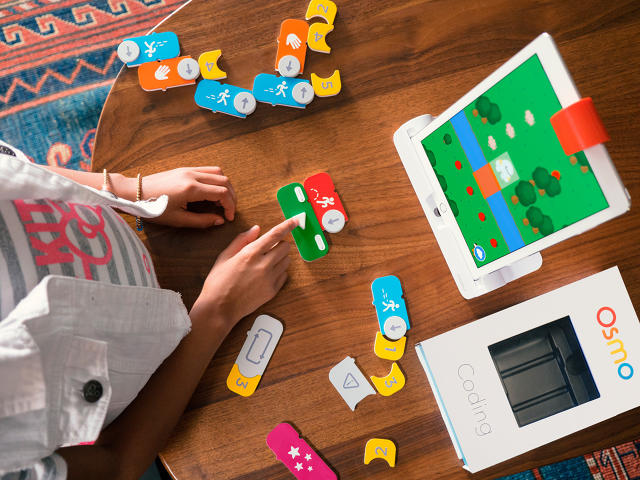Coding is notoriously abstract, yet consensus increasingly says we need to be teaching it to our kids as early as possible. So how do you teach abstract logic to kids who haven't even necessarily worked out their core motor functions yet? By making the process of getting better at one the same as improving the other.
That's the idea behind Osmo Coding, the latest game to promise to help eager parents teach their kids how to program. The game borrows Lego-like design principles to transform abstract bits of computer code (if-then statements, loops, and so on) into colorful blocks that magnetically snap together.

Like many other programming games such as Robot Turtles, Osmo Coding asks kids to move a fun character to achieve a goal or move past obstacles using simple coding concepts. In Osmo's case, that character is named Awbie, a blue cartoon anthropophage and strawberry glutton.
Awbie is a digital character, living behind the screens of a nearby iPad, who asks children for help navigating around his island home and finding new fruit to eat. To move Awbie, kids snap together Osmo blocks for walking, jumping, or grabbing, into a chain of commands. Each command is modifiable with a counter, so by snapping a number onto the side of a block, you can tell Awbie to walk four steps ahead, or jump twice in succession. You can even loop commands.
One distinct thing about Osmo Coding is that the blocks are completely analog, even though they control a digital character. There's no Wi-Fi or Bluetooth in these blocks. Instead, Osmo Coding uses computer vision technology to recognize the colors and patterns of blocks placed in front of an iPad's camera and translate that into commands. That keeps the price of Osmo Coding cheap: The core game costs only $49.
But even though the blocks in Osmo Coding are quote-unquote "dumb," they were the most important thing to get right, says Osmo CEO and cofounder Pramod Sharma. "Physical interaction is still a really powerful way to teach children," Sharma says. "Comparatively, putting together something on a screen is still really hard for them." Kids still need to learn by play.

For inspiration on how their blocks should work, Osmo's team looked at what they saw as the core design principles of Lego. First of all, says Sharma, Lego bricks are intuitive: "Kids don't need to be told how to put them together." Osmo couldn't exactly steal Lego's extremely well-patented interlocking system, but by using magnets, it was able to mimic the intuitiveness of Lego. They snap together easily, and they're impossible to connect incorrectly.
Osmo also noted that, while colorful, Lego bricks are not explicitly gendered: "They come in colors that feel good to both boys and girls," says Sharma. That was a design trick Osmo decided to copy for its blocks, taking pains to choose primary colors that wouldn't subliminally discourage boys or girls from engaging.
Another important consideration for Osmo's blocks is that they be as expandable as Lego. Every kid who gets into Lego starts with one or two sets and builds their collection out over time; Osmo should do the same. So in the future, Osmo Coding might add new blocks, representing new commands. Since the "blocks" themselves are just physical tokens, which an iPad's camera translates into code, it should be easy to add new functionality over time and expand the library of blocks so that kids are constantly able to do new things.
"Lego inspired an entire generation of engineers," says Sharma. "We want to try to be the same thing for the next generation of coders."